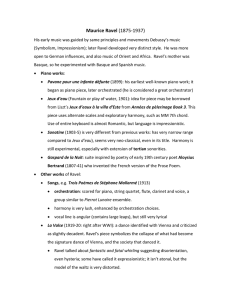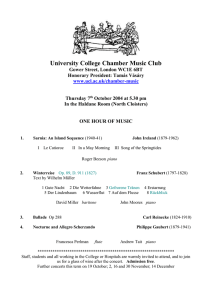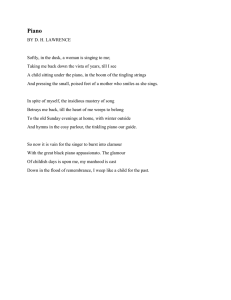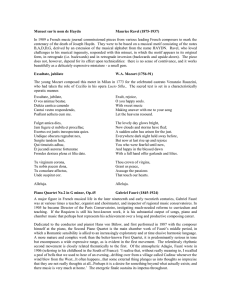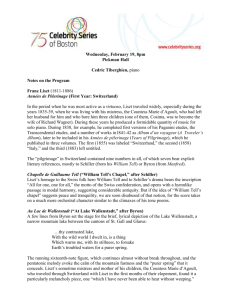History of Music, Mr. Robert L. Johnston Who was Ravel?
advertisement
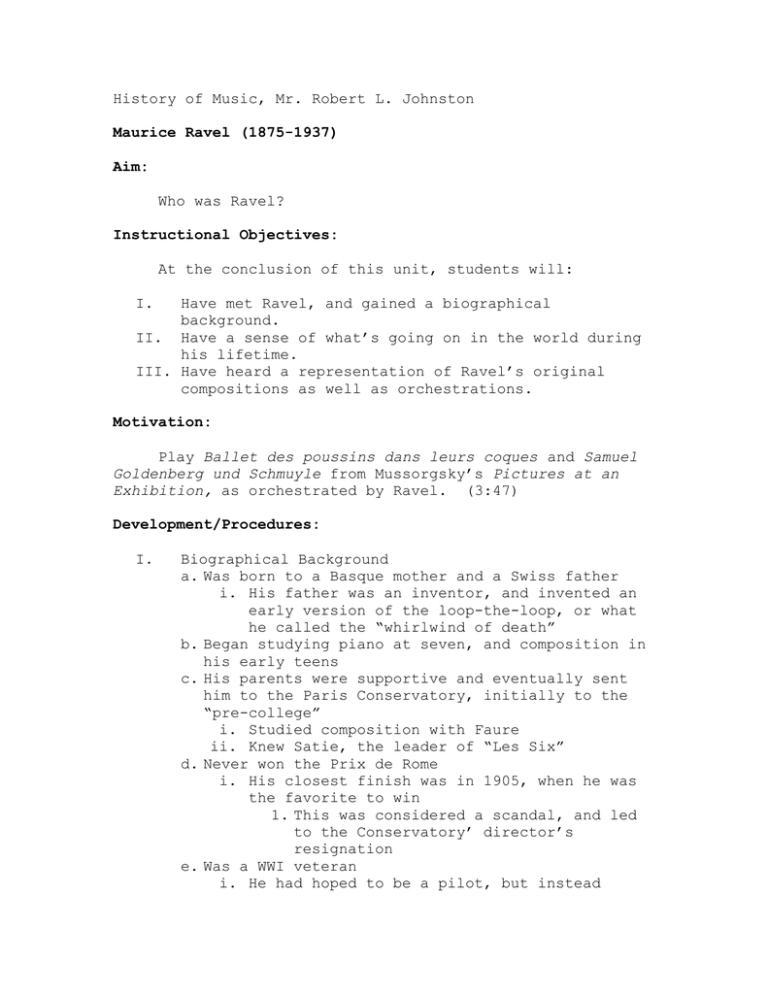
History of Music, Mr. Robert L. Johnston Maurice Ravel (1875-1937) Aim: Who was Ravel? Instructional Objectives: At the conclusion of this unit, students will: I. Have met Ravel, and gained a biographical background. II. Have a sense of what’s going on in the world during his lifetime. III. Have heard a representation of Ravel’s original compositions as well as orchestrations. Motivation: Play Ballet des poussins dans leurs coques and Samuel Goldenberg und Schmuyle from Mussorgsky’s Pictures at an Exhibition, as orchestrated by Ravel. (3:47) Development/Procedures: I. Biographical Background a. Was born to a Basque mother and a Swiss father i. His father was an inventor, and invented an early version of the loop-the-loop, or what he called the “whirlwind of death” b. Began studying piano at seven, and composition in his early teens c. His parents were supportive and eventually sent him to the Paris Conservatory, initially to the “pre-college” i. Studied composition with Faure ii. Knew Satie, the leader of “Les Six” d. Never won the Prix de Rome i. His closest finish was in 1905, when he was the favorite to win 1. This was considered a scandal, and led to the Conservatory’ director’s resignation e. Was a WWI veteran i. He had hoped to be a pilot, but instead ended up as a truck driver f. Worked and traveled as a conductor i. Tours included performances in the United States 1. He met George Gershwin a. Ravel at the piano, accompanied by Canadian singer Éva Gauthier, during his American tour, March 7, 1928. At far right is George Gershwin. http://en.wikipedia.org/wiki/Image:Ravel_au_piano.jpg 2. He was influenced by Jazz a. Play Sonata for Violin and Piano: II. Blues: Moderato (5:24) g. Worked with the Ballet Russe i. You will remember that Debussy had written Prélude À L'Après-Midi D'Un Faune for the Ballet Russe ii. Soon, we will meet Stravinsky, whose association with the Ballet Russe is the most famous and important of any composer iii. Three prominent works either danced by or commissioned by the Ballet Russe were 1. Ma Mère l'Oye (Mother Goose Suite) a. Originally for piano duet, the orchestrated work requires i. Piccolo ii. 2 Flutes iii. 2 Oboes iv. English Horn v. 2 Clarinets vi. 2 Bassoons and Contrabassoon vii. 2 French Horns viii. Timpani ix. Bass Drum, Cymbals, Triangle, Tam Tam, Glockenspiel, Xylophone, Celesta x. Strings xi. Harp xii. No Trumpets, Trombones, Tuba b. Play the final movement, “The Enchanted Garden” (9:28) 2. Daphnis et Chloé a. The lead was danced by Nijinsky b. Play Daphnis et Chloé Suite No. 2 (15:10) c. Note, this is three contiguous movements 3. La Valse h. Died from complications due to a head injury from a taxi accident i. He had experimental brain surgery i. Maurice Ravel in 1912 http://en.wikipedia.org/wiki/Image:Maurice_Ravel_1912.jpg j. Caricature http://www.naxos.com/composerinfo/bio21012.htm II. What’s Concurrent? a. Industrial Revolution b. American-Indian Wars, Battle of Little Big Horn c. Beginning of NY Yankees d. WWI e. Russian Revolution f. Great Depression g. Birth of Jazz h. Creative life of Coco Chanel in Paris i. Beginning of creative life of Pablo Picasso j. Invention of the airplane, phonograph, etc. i. There are even recordings of Ravel III. Musical Style a. As we learned with Debussy, Impressionism in music tries to evoke moods, atmosphere and sensuous impressions through different harmonies and timbres. b. Differed from Debussy, his contemporary and Rival in his “sharply defined ideas” and “closed formal units” c. Influenced by other national and/or geographic styles i. In particular, Spain ii. Play Bolero, perhaps his most famous work (14:19) d. Can be considered one of the progenitors of the neo-classic style i. This is apparent in his adherence to formal structure ii. He had a strong relationship with Stravinsky, the other name best associated with this movement iii. Play the Rigaudon from Le tombeau de Couperin (2:59) e. Master Orchestrator i. We heard the Pictures at an Exhibition, and he is known for orchestrating his own and other composer’s piano works IV. Compositional Output a. Orchestral music, including i. Rapsodie espagnole (Spanish Rhapsody, 1908) ii. Piano Concerto for the Left Hand (1930) iii. Piano Concerto in G (1931) b. Ballets, including i. Ma mère l'oye (Mother Goose, 1911) ii. Daphnis et Chloé (1912) iii. La valse (1920) iv. Boléro (1928) c. 2 operas i. L'heure espagnole (The Spanish Hour, 1911) ii. L'enfant et les sortilèges (The Child and the Enchantments, 1925) d. Chamber music, including i. A string quartet (1903) ii. Sonatas for violin and cello (1922) iii. Violin and piano (1927) iv. A piano trio (1914) e. Piano music, including i. Pavane pour une infante défunte (Pavane for a Dead Princess, 1908, orchestrated 1910) ii. Jeux d'eau (Fountains, 1901) iii. Gaspard de le nuit (Gaspard of the Night, 1908) iv. Ma mère l'oye (4 hands, 1910, later orchestrated) v. Le tombeau de Couperin (The Tomb of Couperin, 1917, orchestrated 1919) f. Songs with instruments, including i. Sheherazade (1903) ii. Chansons madécasses (Songs of Madagascar, 1925-26) Materials of Instruction: Smart Board Various Recordings Summary: Ravel has his own unique voice of texture, harmony and form. He has strong connections to the past, while looking forward. His abilities as a pianist, along with his understanding of how the orchestra works, further enhance his stature in the cannon of elite composers. His music is the favorite of many astute musicologists, musicians, and music lovers alike, for both its aesthetic and its intellectual characteristics. Assignment: Research the background and important figures in the Ballet Russe. Be sure to mention Debussy, Ravel, Stravinsky, Sergei Diaghilev, Vaslav Nijinsky and George Balanchine. Bibliography: http://en.wikipedia.org/wiki/Maurice_Ravel http://en.wikipedia.org/wiki/Ma_M%C3%A8re_l%27Oye http://w3.rz-berlin.mpg.de/cmp/ravel.html http://www.essentialsofmusic.com/ New York Philharmonic, Giuseppe Sinopoli, Pictures at an Exhibition, Night on Bald Mountain, Valses nobles et sentimentales, 1991, Deutsche Grammophon Sarah Chang & Lars Vogt, Sonatas for Violin & Piano, (p) 2004, EMI Charles Dutoit, Montreal Symphony, Ravel, (p) & (c) 1984, The Decca Record Company, Ltd., London Leonard Bernstein, New York Philharmonic & Schola Cantorum, Great Performances - Ravel: Bolero, La valse, Rapsodie espagnole, Alborada del Gracioso, Daphnis et Chloé Suite No. 2, (p) 2006 Sony BMG Music Entertainment Suggested Reference: History of Music, Hugh H. Miller, Barnes & Noble Books, New York. 1972 Robert L. Johnston
